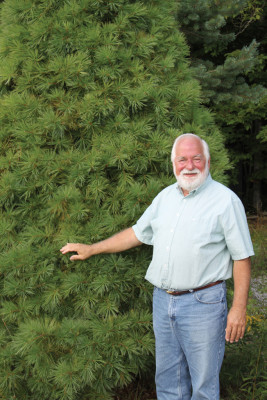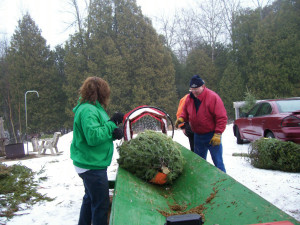Growing the Holiday Spirit
- Share
- Tweet
- Pin
- Share

Ken Ottman fits the role of selling Christmas trees. His big white beard surrounds an everlasting smile that pairs with big-bellied laughter at the sound of his own jokes. Every season, as the holiday approaches, Ottman and his family spend more time in Door County doing the fun part of tree farming.
“The retailing part is fun,” said Ottman. “It’s fun to help families, to see them smile when they find the perfect tree. It’s a happy business.”
In the Midwest we are primed to think of farms as places of crop fields, livestock and big red barns. It is the land where we cultivate the commodities that we use to sustain ourselves. After the decay of fall, their use falls dormant until spring when it starts all over again.

Photo by Jackson Parr.
But there is another kind of farm that steals the spotlight in this agriculture offseason and it takes just as much work to cultivate.
“I like to say that if we made minimum wage for all of those hours that we spent, I would be tickled to death,” said Ottman between laughs. “The growing of the Christmas trees is just work.”
The 40-acre plot at Ottman’s Fir Farm in Fish Creek has been in the family for more than 100 years. Living in Milwaukee, the family wasn’t going to be in the county frequently enough to grow traditional Door County cherries so Ken’s parents, Herb and Dorothy, planted 15,000 fir trees when they got the land from their parents.
Herb was in the Christmas tree retail business for 25 years before they started to bring their entire Christmas tree operation in house by growing the trees on their own land. As a painting contractor, Herb needed something to do in the month before Christmas, a time when the painting business died down.
“Using the paints that they were using right after World War II, nobody wanted you in their house right before Christmas because it reeked,” said Ken. “It was all oil-based paints and nobody wanted their house painted just before Christmas.”
By selling Christmas trees, Herb could fill out his year with good work and a little extra cash.
At this time, 10-year-old Ken began helping with the business throughout the year. He believes it played a role in his education in forestry and career in urban and residential forestry. All through his life he has seen the life cycle of his Christmas trees ending with some twine on the top of a car filled with smiling people.
This life cycle is not only a long process, taking approximately 15 years from seedling to full maturation, but a labor intensive one as well.
“Different species of trees grow at different rates and have different soil requirements and we’ve made our share of mistakes here in planting the wrong species at this site,” said Ken. “One year I remember we planted 5,000 trees and lost 5,000 trees,” referring to a drought that stunted the seedlings as soon as they hit the soil.

Photo by Jackson Parr.
Each tree is hand-planted and Ken typically plants a couple thousand trees each year. Once the trees reach maturity, annual shearing of the branches, checking for insect and disease problems, and mowing the 40-acre plot comprises most of the work. Ken and his family visit Door County about 20 weekends each year to maintain the site and get it ready for the whirlwind month before Christmas when local and visiting families come to cut their own Christmas trees.
The Christmas tree business is in decline with the expansion of artificial trees. The American Christmas Tree Association says that in the 94 million American households where Christmas trees are on display, 81 percent are artificial and only 19 percent are real trees.
But Ken claims their farm is selling more trees now than before.
“Being in Door County like this, and Door County focusing on traditional Christmas themes, it fits,” said Ken. “It fits in with people going to gingerbread-decorated houses and inns. The call back to a real tree seems to fit that up here. It seems this is what people want to have.”
After the final tree moves off the lot before Christmas and the last of the hot chocolate is gone, the Ottman family returns home and rests.
“We always said if there’s anything that we need to get done the first two weeks of January then we’re out of luck because we have no energy left,” said Ken. In the spring, he attends some Christmas tree grower meetings and before long, puts his order in for the next round of trees to be planted.
In the middle of April, he is back out there, driving a hole into the ground and dropping saplings one by one.
Ken doesn’t give much consideration to why he continues farming Christmas trees.
“If somebody were to ask me, ‘I’ve got 40 acres, I’d like to start a Christmas tree farm,’ I’d tell them to think about any other options before you plant Christmas trees. You really got to like what you’re doing.”
The mindless shearing is cathartic, the smiling families are infectious, and it has helped pay for his children’s college educations. It has provided a means for his family to work together and continue the legacy of Ken’s parents.
“My wife asked me how long are we going to do this and I said they’re probably going to have to drag me out of the field by my heels,” said Ken. “But we’re here in Door County. How bad can it be?”
Ottman’s Fir Farm is located at 9248 County Road A, east of Fish Creek. They are open weekends through Christmas from 10 am until dark. In Southern Door, the County H Tree Farm is open Wednesday through Sunday from 8:30 am to 4:30 pm beginning November 28th.
Cutting Your Own Christmas Tree
What to Bring
Part of the wonder of cutting your own Christmas tree is the hands-on labor after scouring the field looking for the perfect one. But the number one rule of cutting your own tree is to come prepared.
Saw: Chainsaws are not allowed on many choose-and-cut lots, but for the majority of trees, a normal handsaw will do the trick. Leave the ax at home as it will create a messy splintered base that you will struggle to fit in your tree stand at home.
Twine: Or anything that you can use to tie the tree to your car, such as a bungee cord.
Tarp: Trees can dry out quickly once they are cut, especially in the cold winds on top of a vehicle. Wrapping your tree in tarp can hold in some moisture until you get it home and watered. The longer you have to drive, the more this rule applies. This also serves to protect the paint and finish on top of your vehicle.
Appropriate clothing: The busiest weekends for choose-and-cut operations tend to be immediately after Thanksgiving. Frequently, the days can still be warm enough to melt any snow that falls, creating a wet, muddy field. Bring good boots, jeans that can get a little dirty, and thick gloves to handle the tree while you cut.
After Christmas
The traditional way to recycle trees is sending them to the wood chipper and getting some mulch for the spring in return. Some municipalities in the county provide free tree recycling after Christmas. But across the country, people have found other uses for old Christmas trees.
Soil erosion barriers: New Jersey used thousands of Christmas trees to help restore the ocean-side sand dunes after Hurricane Sandy. The old trees help build the dunes up to provide a natural barrier to potentially harmful weather coming across the water.
Fish feeders: Sinking the trees in a shallow pond can provide habitat and feeding areas for fish.
Bird sanctuary: Standing the tree up in your backyard can serve as a large bird feeder, giving birds a place to shelter when they return in the spring. Just be sure to take the hooks, ornaments and tinsel off first.
Fertilizer: With local permission, you can burn your tree and spread the ashes on your home garden, providing nutrients to the soil.
Potpourri: Strip the branches of their needles and place them in brown paper bags where they will retain their woodsy scent.



